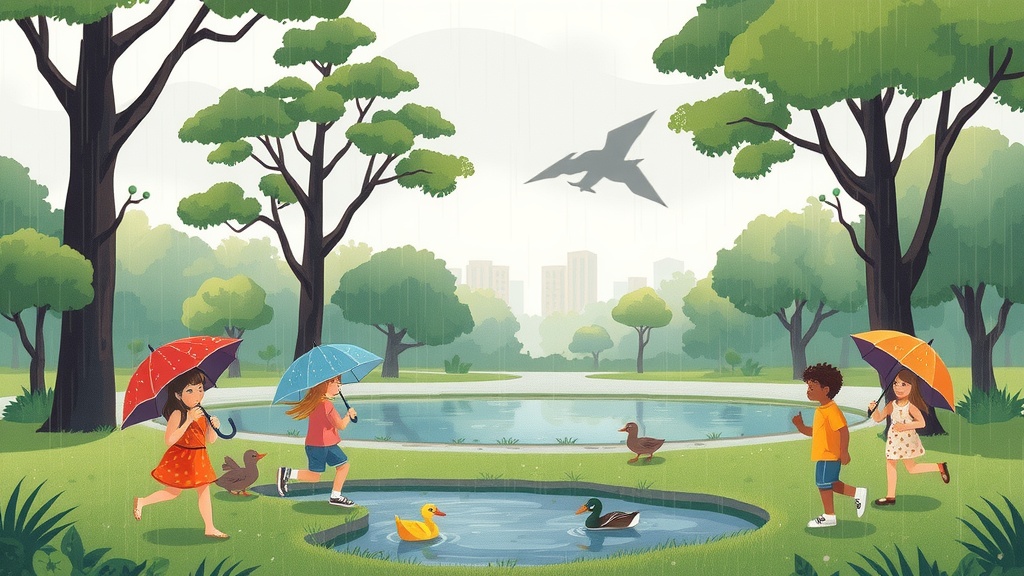Imagine the world washed clean, every leaf glistening, and the air filled with the earthy scent of wet soil. That’s the magic of a rainy day! For students in Bangladesh, from Class 6 to HSC, a rainy day is more than just weather; it's an experience, a memory, and a perfect subject for a paragraph. Let's explore how to craft compelling paragraphs about rainy days, tailored to different word counts and educational levels.
The Allure of a Rainy Day: Why Write About It?
Why are rainy days such a popular topic in essays and paragraphs? Well, think about it. In a country like Bangladesh, where the monsoon season is a significant part of our lives, rainy days evoke strong emotions and vivid imagery. They offer a break from the heat, a chance to relax, and a unique perspective on the world around us. Writing about rainy days allows us to tap into these shared experiences and express our creativity.
A Rainy Day Paragraph: Setting the Stage
Before we dive into specific examples, let's consider what makes a good "A Rainy Day Paragraph." It's not just about describing the rain; it's about capturing the feeling of the day. Think about these elements:
- Sensory Details: What do you see, hear, smell, and feel?
- Personal Connection: What memories or emotions does the rainy day evoke?
- Descriptive Language: Use vivid words and phrases to paint a picture for the reader.
- Structure: Organize your thoughts logically, with a clear beginning, middle, and end.
Rainy Day Paragraph Examples for Different Classes
Let's look at some examples tailored for different class levels and word counts. Remember, these are just starting points; feel free to adapt them to your own experiences and writing style.
A Rainy Day Paragraph for Class 6 (150 Words)
The sky turned gray, and then the rain started. Big drops fell on the tin roof, making a loud thump-thump sound. I ran to the window and watched the water running down the street. The trees looked shiny and green after the rain washed them clean. My little brother was splashing in the puddles, laughing with joy. Inside, Ammu made hot khichuri, and we all ate together. The rain made everything feel cozy and warm. Even though I couldn't go outside to play, I enjoyed the rainy day with my family. It was a special day because we spent time together, listening to the rain and enjoying each other's company. The air smelled fresh and clean after the rain stopped.
A Rainy Day Paragraph for Class 7-8 (200 Words)
A rainy day is a welcome change, especially after a long spell of hot weather. The sky darkens, and heavy clouds gather, promising relief. Soon, the first drops begin to fall, growing into a steady downpour. The sound of rain drumming on the roof is like a soothing melody. Children love to play in the rain, splashing through puddles and making paper boats to sail down the flooded streets. Adults, too, find a certain charm in the rain, enjoying a cup of tea while watching the world outside transform into a watery landscape. Sometimes, a heavy rain can cause waterlogging, making it difficult to travel. However, the refreshing coolness and the clean, washed air make it all worthwhile. A rainy day is a reminder of nature's power and beauty, a day to slow down and appreciate the simple things in life.
A Rainy Day Paragraph for Class 9-10, SSC (250 Words)
Rainy days hold a special place in the hearts of people in Bangladesh. They bring respite from the scorching heat and dust, transforming the environment into a lush, vibrant landscape. The arrival of the monsoon is often celebrated, and rainy days are seen as a blessing. However, they also bring challenges. Heavy rainfall can lead to waterlogging in urban areas, disrupting traffic and daily life. In rural areas, excessive rain can damage crops and cause flooding, impacting livelihoods. Despite these challenges, the beauty and tranquility of a rainy day are undeniable. The sound of rain falling on the tin roof of a village home, the sight of children playing in the muddy fields, and the smell of wet earth are all quintessential images of a rainy day in Bangladesh. It’s a time for reflection, for spending time with family, and for appreciating the simple joys of life. The contrast between the chaos and calm makes a rainy day a memorable experience.
A Rainy Day Paragraph for Class 11-12, HSC (300 Words)
A rainy day is a multifaceted experience, particularly in the context of Bangladesh. Beyond the immediate relief from the oppressive heat, it represents a complex interplay of nature's bounty and its potential for disruption. The monsoon season, characterized by frequent and intense rainfall, is crucial for agriculture, replenishing water resources and sustaining the country's predominantly agrarian economy. However, the same rains can also trigger devastating floods, displacing communities and causing widespread damage to infrastructure and crops.
The socio-economic impact of a rainy day is therefore significant. While farmers welcome the rain for its life-giving properties, urban dwellers often face traffic congestion, waterlogging, and the risk of waterborne diseases. The contrast between the rural and urban experience highlights the need for effective water management and infrastructure development to mitigate the negative consequences of heavy rainfall.
Culturally, rainy days evoke a sense of nostalgia and romance. They are often associated with cozy indoor activities, such as reading, listening to music, and sharing stories with family. The rhythmic sound of rain on the roof, the earthy scent of wet soil, and the sight of lush greenery create a sensory experience that is both calming and invigorating. A rainy day, in essence, is a reminder of the power and beauty of nature, and the importance of living in harmony with the environment. It is a time for reflection, resilience, and a celebration of the life-giving force of water.
Deeper Dive: Crafting the Perfect Rainy Day Paragraph
Now that we've seen some examples, let's break down the key elements of a great rainy day paragraph.
Sensory Details: Painting a Picture with Words
The best way to bring your rainy day paragraph to life is to use vivid sensory details. Think about:
- Sight: What colors do you see? Are the clouds dark and ominous, or light and fluffy? Is the rain falling in sheets, or is it a gentle drizzle?
- Sound: What sounds do you hear? The pitter-patter of rain on the roof, the whoosh of cars driving through puddles, the distant rumble of thunder?
- Smell: What scents fill the air? The fresh, earthy smell of wet soil, the petrichor (the smell of rain on dry earth), the aroma of hot tea or pakoras cooking inside?
- Touch: How does the rain feel on your skin? Cool and refreshing, or cold and biting?
- Taste: Does the air have a certain taste? Perhaps a hint of ozone after a thunderstorm?
Example:
Instead of saying, "It was raining," try:
"The rain lashed against the windowpane, a furious torrent that blurred the world outside. The air hung heavy with the scent of wet earth, a primal aroma that awakened something deep within me. Each drop felt like a tiny ice cube against my skin, a stark contrast to the humid air that had preceded the storm."
Personal Connection: Making it Your Own
A rainy day paragraph is more than just a description of the weather; it's a reflection of your personal experience. What does a rainy day mean to you?
- Memories: Does it remind you of a specific event or person?
- Emotions: Does it make you feel happy, sad, nostalgic, or peaceful?
- Activities: What do you typically do on a rainy day?
- Observations: What do you notice about the world around you on a rainy day?
Example:
"Rainy days always remind me of my grandmother. She used to make hot pitha and tell us stories while we huddled around the fire, listening to the rain. The smell of her cooking and the sound of her voice are forever intertwined with the memory of those cozy rainy afternoons."
Descriptive Language: Choosing the Right Words
The words you choose can make all the difference in a rainy day paragraph. Avoid clichés and try to find fresh, original ways to describe the rain and its effects.
- Similes and Metaphors: Compare the rain to something else to create a vivid image. "The rain fell like a curtain of tears," or "The city was a canvas washed with gray."
- Personification: Give the rain human qualities. "The rain whispered secrets to the trees," or "The storm raged with fury."
- Adjectives and Adverbs: Use descriptive words to add detail. "The torrential rain," "The rain fell relentlessly."
- Active Verbs: Use strong verbs to create a sense of action. "The rain pounded the roof," "The wind whipped through the trees."
Example:
Instead of saying, "The rain was heavy," try:
"The rain descended in thick, silver ropes, each drop a tiny hammer against the corrugated iron roof. The wind, a mischievous imp, tugged at the trees, bending them low in supplication."
Structure: Organizing Your Thoughts
A well-structured paragraph is easy to read and understand. Here's a simple structure you can follow:
- Topic Sentence: Start with a sentence that introduces the main idea of the paragraph.
- Supporting Sentences: Provide details and examples to support your main idea.
- Concluding Sentence: Summarize your main idea and leave the reader with a final thought.
Example:
"A rainy day in Dhaka is a study in contrasts. [Topic Sentence] The city, usually bustling with activity, slows to a crawl as traffic snarls and pedestrians seek shelter. [Supporting Sentence 1] Yet, amidst the chaos, there's a certain beauty to be found in the reflections on the wet streets and the vibrant colors of umbrellas dotting the landscape. [Supporting Sentence 2] A rainy day, therefore, offers a unique perspective on the city, a chance to see it in a different light. [Concluding Sentence]"
Common Mistakes to Avoid
- Clichés: Avoid overused phrases like "raining cats and dogs."
- Repetition: Use synonyms and varied sentence structures to avoid repeating the same words or phrases.
- Vague Language: Be specific and use concrete details.
- Grammatical Errors: Proofread your work carefully to catch any errors in grammar or spelling.
Frequently Asked Questions (FAQs)
Let's address some common questions about writing a rainy day paragraph.
What if I don't like rainy days? Can I still write a good paragraph?
Absolutely! You don't have to love rainy days to write a compelling paragraph about them. In fact, writing about your dislike of rainy days can be even more interesting. Focus on the negative aspects of rainy days, such as the inconvenience, the gloominess, or the disruption to your plans. Use strong language to express your feelings and explain why you dislike them.
How can I make my rainy day paragraph more interesting?
- Tell a Story: Instead of just describing the rain, tell a story about something that happened to you on a rainy day.
- Focus on a Specific Detail: Zoom in on one particular aspect of the rainy day, such as the way the rain sounds on the roof, or the way the light looks through the clouds.
- Use Humor: If appropriate, inject some humor into your paragraph.
- Ask a Question: Start or end your paragraph with a thought-provoking question.
How can I improve my vocabulary for writing about rainy days?
- Read Widely: Pay attention to how other writers describe rain and weather in their work.
- Use a Thesaurus: Look up synonyms for common words like "rain," "storm," and "wet."
- Keep a Vocabulary Journal: Write down new words and phrases that you come across, along with their definitions and examples of how to use them.
How to write a rainy day paragraph in Bangla?
While this article focuses on writing in English, the principles remain the same. Think about the sensory details, your personal connection to rainy days in Bangladesh, and use descriptive language that resonates with Bangla culture. For example, you might describe the sound of rain on a chala ghor (thatched roof) or the joy of eating ilish mach bhaja (fried hilsa fish) on a rainy day.
Table: Comparing Paragraph Lengths
| Feature | 150 Words (Class 6) | 200 Words (Class 7-8) | 250 Words (Class 9-10, SSC) | 300 Words (Class 11-12, HSC) |
|---|---|---|---|---|
| Complexity | Simple sentences | Compound sentences | Mix of simple & complex | Complex sentences |
| Vocabulary | Basic | More varied | Sophisticated | Highly nuanced |
| Focus | Personal experience | General observations | Socio-cultural context | Deeper analysis |
| Sentence Length | Short | Medium | Medium-Long | Long, varied |
| Level of Detail | Less | More | Significant | Extensive |
Secondary Keywords Integration
Let's see how we can naturally incorporate related keywords and questions:
- "Rainy day paragraph Bangla meaning": While the paragraph itself is in English, understanding the cultural significance of rainy days in Bangladesh, as discussed earlier, will enrich your writing.
- "Paragraph on rainy day for class 6": The 150-word example provides a suitable template.
- "Paragraph on rainy day for SSC/HSC": The 250 and 300-word examples cater to these levels.
- "How to describe a rainy day": The sections on sensory details and descriptive language address this directly.
Beyond the Paragraph: Expanding Your Rainy Day Writing
Once you've mastered the art of the rainy day paragraph, you can explore other forms of writing, such as:
- Essays: Expand on the themes and ideas presented in your paragraph to create a longer, more detailed essay.
- Poems: Use imagery and rhythm to capture the essence of a rainy day in verse.
- Short Stories: Create a fictional narrative set on a rainy day.
- Journal Entries: Write about your personal experiences and reflections on a rainy day.
Rainy Day Activities: Inspiration for Your Writing
Sometimes, the best way to write about a rainy day is to experience it. Here are some activities you can do on a rainy day that might inspire your writing:
- Listen to the Rain: Close your eyes and focus on the different sounds of the rain.
- Watch the Rain: Observe how the rain transforms the landscape.
- Read a Book: Curl up with a good book and let the rain create a cozy atmosphere.
- Cook a Meal: Prepare a comforting meal, such as khichuri or dal, and enjoy it with your family.
- Play a Game: Play a board game or card game with your family or friends.
- Write in Your Journal: Reflect on your thoughts and feelings about the rainy day.
Conclusion: Embrace the Rainy Day
A rainy day paragraph is more than just an assignment; it's an opportunity to connect with nature, explore your emotions, and express your creativity. By using vivid sensory details, personal connections, and descriptive language, you can craft a compelling paragraph that captures the essence of a rainy day. So, the next time it rains, don't just see it as an inconvenience; see it as an inspiration.
Now, it's your turn! Grab a pen and paper (or open your laptop) and start writing your own rainy day paragraph. What are your favorite rainy day memories? What makes a rainy day special to you? Share your thoughts in the comments below! Let's celebrate the beauty and wonder of rainy days together. And remember, every drop of rain holds a story waiting to be told. What's yours?




